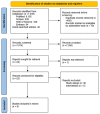Online Occupational Therapy as a Rehabilitation Intervention for Parkinson's Disease: A Systematized Review
- PMID: 40558216
- PMCID: PMC12191676
- DOI: 10.3390/clinpract15060098
Online Occupational Therapy as a Rehabilitation Intervention for Parkinson's Disease: A Systematized Review
Abstract
Background/Objectives: Occupational therapy (OT) plays a crucial role in addressing functional limitations and promoting independence in Parkinson's disease (PD) patients. OT interventions target motor skills, daily activities, and engagement in meaningful tasks. Telehealth, the remote delivery of healthcare services, has expanded access to rehabilitation, including OT for PD. While several studies have examined the benefits of online OT, a comprehensive assessment of its impact on functional outcomes and quality of life (QoL) is needed. This review aimed to evaluate the effects of online OT interventions on functional outcomes and QoL of patients with PD. Methods: This review employed a systematized approach, guided by the Preferred Reporting Items for Systematic Reviews and Meta-Analyses (PRISMA) framework, though it did not constitute a full systematic review or meta-analysis. A comprehensive search was conducted across PubMed, Web of Science, Scopus, and Embase databases between August 2023 and September 2024. The search targeted randomized controlled trials (RCTs) investigating telerehabilitation interventions in OT for individuals with PD. Studies were excluded if they were not published in English, did not employ an RCT design, or lacked a focus on telerehabilitation within the scope of occupational therapy for PD. Additionally, systematic reviews, meta-analyses, qualitative studies, and studies without measurable outcomes were excluded. Nine studies met the inclusion criteria, with four involving occupational therapists directly and five evaluating interventions within the scope of OT practice. Results: The primary outcomes of this review focused on mobility improvements in PD patients, assessed through gait metrics such as gait speed, stride length, and gait variability. Secondary outcomes evaluated the impact of telerehabilitation on QoL, using tools such as the Parkinson's Disease Questionnaire (PDQ-39) and other disease-specific instruments. The findings demonstrated that online OT interventions significantly improved motor skills, cognitive function, and activities of daily living in PD patients. Furthermore, these interventions enhanced overall well-being and QoL. The remote format fostered sustained engagement and adherence to therapy, contributing to better long-term outcomes. Conclusions: Online OT interventions show promising potential for improving functional outcomes and QoL in PD patients. These findings underscore the potential of telehealth to expand access to OT services, thereby enhancing long-term rehabilitation outcomes for this population.
Keywords: Parkinson’s disease; online occupational therapy; quality of life; telerehabilitation.
Conflict of interest statement
The authors declare no conflicts of interest.
Figures
References
-
- Goffredo M., Baglio F., DE Icco R., Proietti S., Maggioni G., Turolla A., Pournajaf S., Jonsdottir J., Zeni F., Federico S., et al. Efficacy of Non-Immersive Virtual Reality-Based Telerehabilitation on Postural Stability in Parkinson’s Disease: A Multicenter Randomized Controlled Trial. Eur. J. Phys. Rehabil. Med. 2023;59:689–696. doi: 10.23736/S1973-9087.23.07954-6. - DOI - PMC - PubMed
-
- Vasconcelos L.A.D.P. Parkinson’s Disease Rehabilitation: Effectiveness Approaches and New Perspectives. In: Bernardo-Filho M., Cunha De Sá-Caputo D., Taiar R., editors. Physical Therapy Effectiveness. IntechOpen; Rijeka, Croatia: 2020.
Publication types
LinkOut - more resources
Full Text Sources
Miscellaneous



